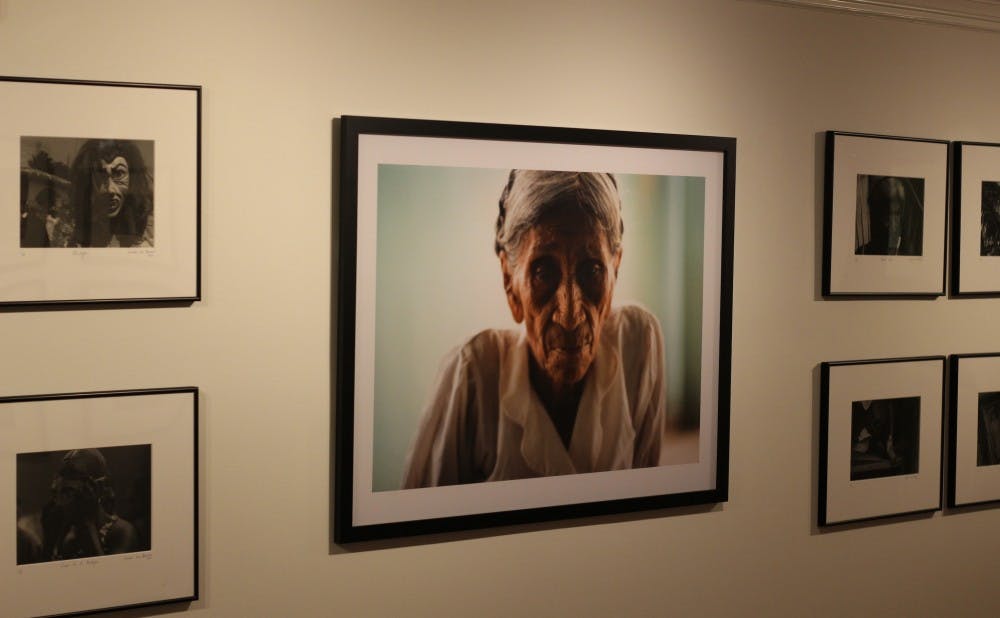Upon entering the main gallery of the John Hope Franklin Center, I found myself feeling slightly overwhelmed. People milled about, entering and exiting a conference room adjacent to the exhibit I’d come to see. At the edge of the gallery, two people conversed about construction. And yet, amid the varied clamor, my mind was elsewhere, in a place I had neither been to nor heard of before: a region of Mexico called the Costa Chica. It is the setting and subject of Sandra Luz Barroso’s photographs now on display in “For Catalina’s Time.”
The exhibit, which also includes ten works of graphic art, arrived at the Franklin Center in mid-September and runs until Dec. 6. The Costa Chica is known as a hub of Afro-Mexican culture, and “For Catalina’s Time” is the product of anthropologist and filmmaker Luz Barroso’s years of field work in the area. Her photographs, taken between 2004 and 2005, capture a range of experiences: a young girl lounging in a hammock, a frenetic, celebratory procession and fragments from the life of Catalina Noyola Bruno, the exhibit’s late namesake.
A brief description of the exhibit, displayed in a corner of the gallery, explains that “For Catalina’s Time” is a means of completing the work begun on “Artemio,” a 2017 documentary by Luz Barroso. Her film follows a young boy — Catalina Noyola’s great-grandson — who was born in the U.S. and travels to the Costa Chica with his mother, who doesn’t have a visa. The documentary screened earlier this month as part of the North Carolina Latin American Film Festival. Miguel Rojas-Sotelo, director of the festival and a curator for Latin America at the Center for Latin American and Caribbean Studies, said “Artemio” ultimately led to “For Catalina’s Time” coming to the Franklin Center.
“We were really happy when engaging for the film festival with … this film about Artemio, we found out that [Luz Barroso] had also developed this exhibit,” Rojas-Sotelo said.
In a recent interview, Laura A. Lewis, professor of anthropology at the University of Southampton and author of “Chocolate and Corn Flour: History, Race, and Place in the Making of ‘Black’ Mexico,” briefly described the backstory of the region and the development of communities of African descent.
Lewis explained that when Spanish conquistadors invaded the region, they brought African slaves and servants with them.
“They were cowboys, they were agricultural workers, and Spaniards used them in their continuing quest to control indigenous peoples on the coast, so that’s how [the Costa Chica] became a very large kind of center of Afro-Mexico,” Lewis said.
Lewis added that anthropological interest in the Costa Chica grew considerably during the 1980s when the Third Root project began researching Mexico’s African descent population.
“There were a number of Mexican anthropologists who started working in the region in the 1980s and then that became sort of the beginning of the current wave of interest in the Afro-Mexican population,” Lewis said.
Among the scenes of contemporary life captured in Luz Barroso’s vibrant black-and-white photographs, there is a symbol of the Costa Chica’s history: a horse’s head carved out of wood. It is a segment of the artesa, an overturned wooden trough or canoe, which people dance atop to narrative-entwined music known as sones de artesa.
In “Chocolate and Corn Flour,” Lewis writes that the popularity of artesa music dwindled in the 1940s and 1950s. In later years, the remaining vestiges of artesa music, found in places like San Nicolás, were then documented and promoted by outsiders, who often profited without reciprocating.
“As traditions long vanished from from people’s day-to-day lives became folklorized, San Nicoladenses thus grew more cynical about those who professed to act on their behalf,” Lewis wrote. “In part this was because cultural promotion did not speak to the community’s social and economic concerns. Furthermore, many community members—including the musicians—saw themselves giving away cultural capital.”
However, “For Catalina’s Time” is not voyeuristic or exploitative. Instead, the exhibit, along with “Artemio,” speaks to the contemporary concerns at play in the Costa Chica, especially those centering on migration. The metal engravings were done by the founding members of a collective of artists from Costa Chica called the Centro Cultural Cimarrón, Talia Weltman-Cisneros, professor of Spanish at the University of North Texas, said.
“I think Sandra’s objective or goal in combining her photography and her film and these engravings were to make a creative space or visibility for Afro-Mexican artists and Afro-Mexican cultural production to be seen and celebrated,” Weltman-Cisneros said.
The fact that the exhibit landed in North Carolina is also culturally significant. The state has become a hub for immigration from the Costa Chica. Weltman-Cisneros worked closely with Luz Barroso to bring the exhibit to the Franklin Center for this very reason.
“I thank Duke University that allow[ed] me to share the work, which is a process that began in anthropology and ends in the cinema that have been ten years of work and for me this exhibition is part of what happened to be able to make the movie ‘Artemio,’” Luz Barroso wrote in an email.
Get The Chronicle straight to your inbox
Signup for our weekly newsletter. Cancel at any time.

